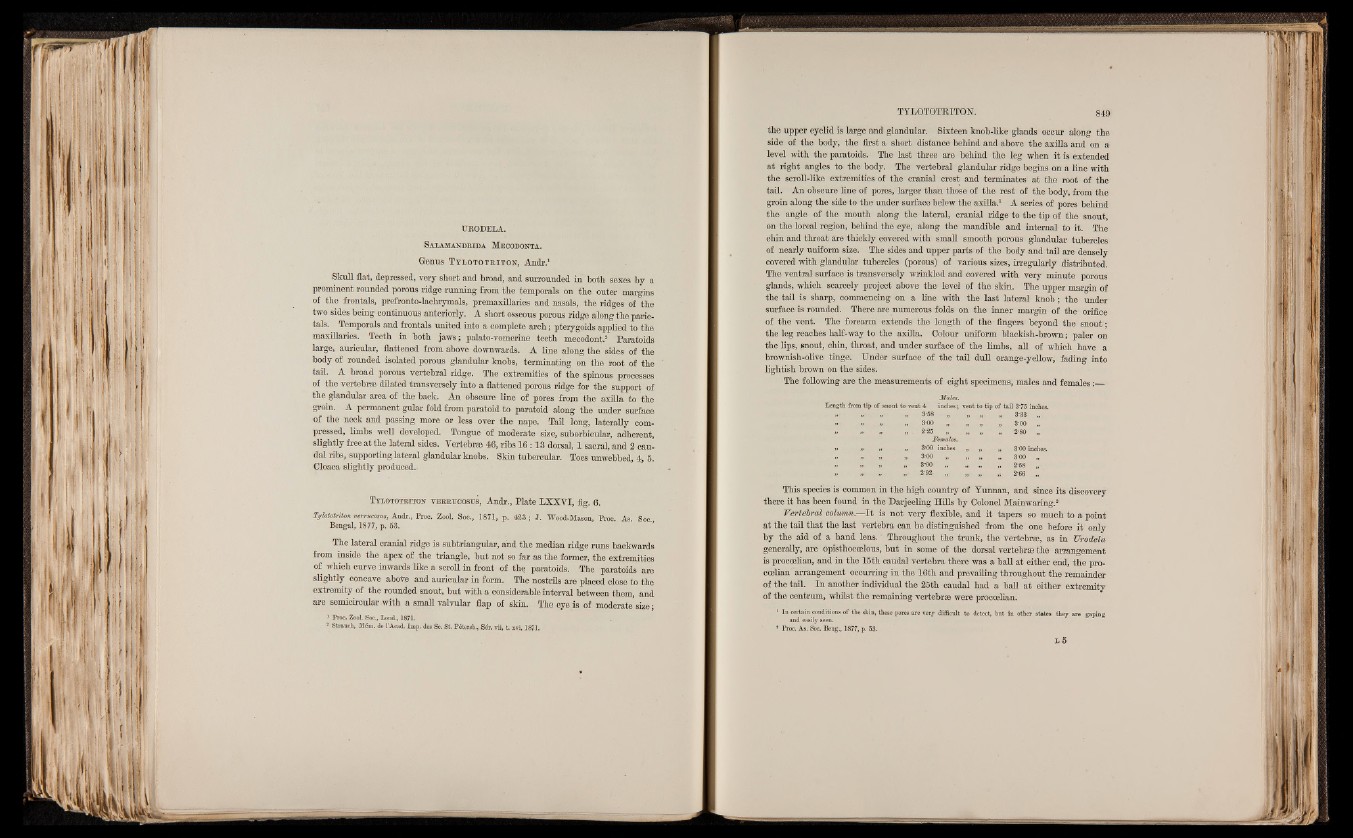
TJEODELA.
S a l a m a n d r i n a M e c o d o n t a .
Genus T y l o t o t r i t o n , Andr.1
Skull flat, depressed, very short and broad, and surrounded in both sexes by a
prominent rounded porous ridge running from the temporals on the outer margins
of tbe frontals, prefronto-lachiymals, premaxillaries and nasals, the ridges of the
two sides being continuous anteriorly. A short osseous porous ridge along the parie-
tals. Temporals and frontals united into a complete arch ; pterygoids applied to the
maxillaries. Teeth in both jaws; palato-vomerine teeth mecodont.1 Paratoids
large, auricular, flattened from above downwards. A line along the sides of the
body of rounded isolated porous glandular knobs, terminating on the root of the
tail. A broad porous vertebral ridge. The extremities of the spinous processes
of the vertebrae dilated transversely into a flattened porous ridge for the. support of
the glandular area of the back. An obscure line of pores from the a-rin» to the
groin. A permanent guiar fold from paratoid to paratoid along the under surface
of the neck and passing more or less over the nape. Tail long, laterally com-
pressed, limbs well developed. Tongue of moderate size, suborbicular, adherent,
slightly free at the lateral sides. Vertebrae 46, ribs 16:13 dorsal, 1 sacral, and 2 caudal
ribs, supporting lateral glandular knobs. Skin tubercular. Toes unwebbed, 4, 5.
Cloaca slightly produced..
T y l o t o t b j t o n v e r r u c o s u s , Andr., P l a t e L X X V T , f i g . 6 .
Tylototriton verrucosus, Andr., Proe. Zool. Soc., 1871, p. 423; It; Wood-Mason, Proc As Soc
Bengal, 1877, p. 53.
The lateral cranial ridge is subtriangular, arid the median ridge runs backwards
from inside the apex of the triangle, but not so far as the former, the extremities
of which curve inwards like a scroll in front of the paratoids. The paratoids are
slightly concave above and auricular in form. The nostrils are placed dose to the
extremity of the rounded snout, but with a considerable interval between them, and
áre semicircular with a small valvular flap of skin. The eye is of moderate size;
1 Proc. Zool. Soc., Lond., 1871.
2 Strauch, Mém. de l’Acad. Imp. des Sc. St. Pétersb., Sér. vii, t. xvi, 1871.
the upper eyelid is large and glandular. Sixteen knob-like glands occur along the
side of the body, the first a short distance behind and above the axilla and on a,
level with the paratoids. The last three are behind the leg when it is extended
at right angles to the body. The vertebral glandular ridge begins on a ling with
the scroll-like extremities of the cranial crest and terminates at the root of the
tail. An obscure line of pores, larger than those of the rest of the body, from the
groin along the side to the under surface below the axilla.1 A series of pores behind
the angle of the mouth along the lateral, cranial ridge to the tip of the snout,
on the loreal region, behind the eye, along the mandible and internal to it. The
chin and throat are thickly covered with small smooth porous glandular tubercles
of nearly uniform size. The sides and upper parts of the body and tail are densely
covered with glandular tubercles (porous) of various sizes, irregularly distributed.
The ventral surface is transversely wrinkled and covered with very minute porous
glands, -which scarcely project above the level of the skin. The upper margin of
the tail is sharp, commencing on a line with the last lateral knob; the under
surface is rounded. There are numerous folds on the inner margin of the orifice
of the vent. The forearm extends the length of the-fingers beyond the snout;
the leg reaches half-way to the axilla. Colour uniform blackish-brown; paler on
the lips, snout, chin, throat, and under surface of the limbs, all of which have a
brownish-olive tinge. Under surface of the tail dull orange-yellow, into
lightish brown on the sides.
The following are the measurements of eight specimens, males and females:_
Males.
Length from tip of snout to vent 4 inches; vent to tip of tail 3*75 inches.
„• . - Hi- | 3-58 „ „ if 33 3
vV l»j% . | . | I 3 00 | „ „ I 3‘0 0 1
» » %; „ 2 2 5 „ „ „ 2-80 r
Females.
ii » n „ 8 00 inches ,, ,, „ 3‘00 inches.
» » >. » 3 0 0 „ „ „ „ 3-00 „
| I „ 1 3*00 g „ | | 2 "58 „
» >*• » » 2-92 ,5 2-66 „
This species is common in the high country of Yunnan, and since its discovery
there it has been found in the Darjeeling Hills by Colonel Mainwaring.2
Vertebral colvmn.—It is not very flexible, and it tapers so much to a point
at the tail that the last vertebra can be distinguished from the one before it only
by the aid of a hand lens. Throughout the trunk, the vertebrae, as in JJrodela
generally, are opisthoccelous, but in some of the dorsal vertebrae the arrangement
is procoelian, and in the 15th caudal vertebra there was a ball at either end, the pro-
coelian arrangement occurring in the 16th and prevailing throughout the remainder
of the tail. In another individual the 25th caudal had a ball at either extremity
of the centrum, whilst the remaining vertebrae were procoelian.
1 I n certain conditions of the skin, these pores are very difficult to detect, but in other states they are gaping
* Proc. As. Soc. Beng., 1877, p. 53.
L 5